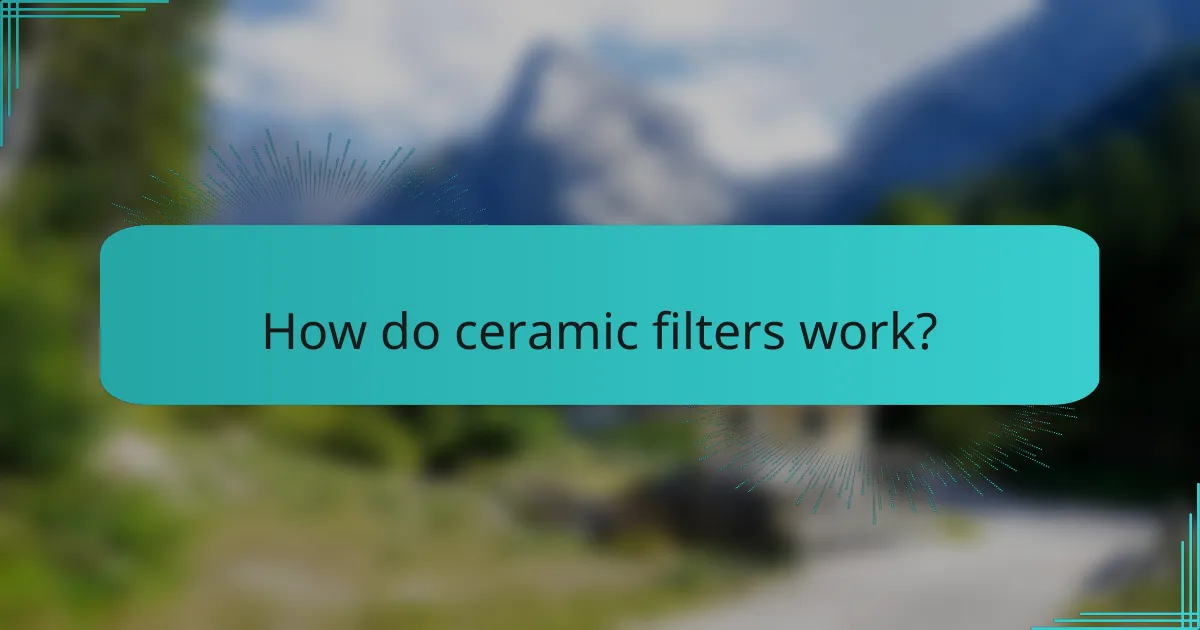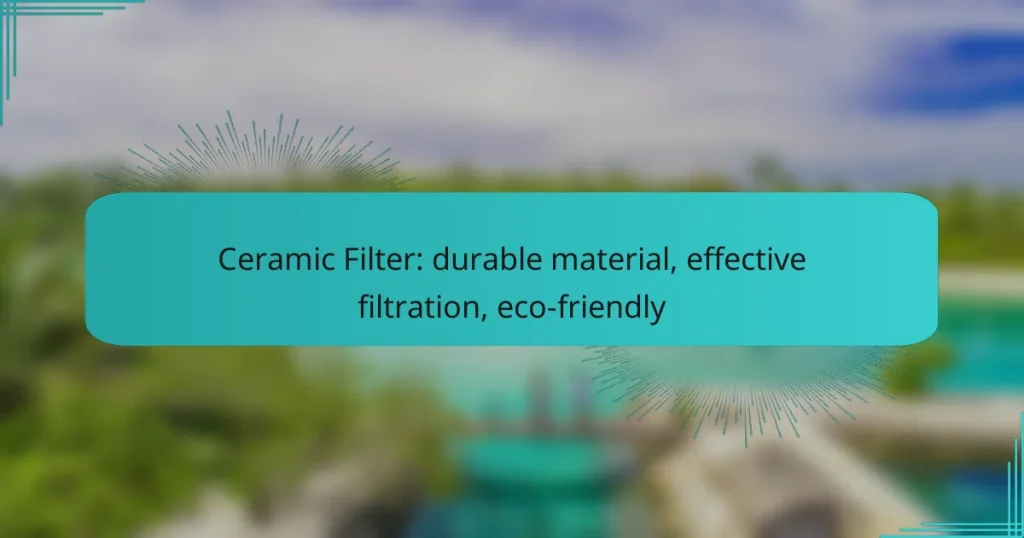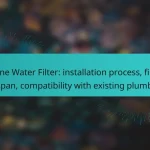Ceramic filters are an excellent choice for water purification, known for their durability, effective filtration, and eco-friendly properties. Utilizing a porous ceramic material, these filters efficiently remove contaminants while allowing clean water to flow through, ensuring safe drinking water. Available in various types, they cater to different filtration needs and applications, making them versatile solutions for effective water treatment.

What are the benefits of ceramic filters in the UK?
Ceramic filters offer several advantages in the UK, including durability, effective filtration, and eco-friendliness. These filters are designed to provide long-lasting performance while ensuring clean drinking water by removing contaminants.
Durability and longevity
Ceramic filters are known for their robust construction, often lasting several years with proper care. Their hard, porous material resists wear and tear, making them suitable for both home and industrial applications.
To maximize the lifespan of a ceramic filter, regular cleaning is essential. Most filters can be easily scrubbed with a soft brush to remove accumulated debris, ensuring continued effectiveness.
Effective filtration of contaminants
These filters excel at removing a wide range of contaminants, including bacteria, sediments, and some heavy metals. The microscopic pores in ceramic materials trap impurities while allowing clean water to pass through.
In the UK, ceramic filters can effectively reduce common waterborne pathogens, making them a reliable choice for households concerned about water quality. Regular testing of filtered water can help ensure that the filtration remains effective over time.
Eco-friendly material
Ceramic filters are made from natural materials, making them an environmentally friendly option compared to plastic filters. Their production typically involves minimal energy use and they can be recycled or disposed of without harming the environment.
Choosing ceramic filters contributes to sustainability efforts by reducing plastic waste. Additionally, their long lifespan means fewer replacements, further decreasing environmental impact.

How do ceramic filters work?
Ceramic filters operate by utilizing a porous ceramic material that effectively removes impurities from water. The filtration process relies on the physical structure of the ceramic, which traps contaminants while allowing clean water to pass through.
Filtration process explained
The filtration process begins when water is introduced to the ceramic filter. As water flows through the porous material, larger particles, bacteria, and sediments are captured within the tiny pores. This results in cleaner water emerging from the other side.
Typically, ceramic filters can remove particles as small as a few microns, making them suitable for various applications, including household water purification and industrial uses. Regular maintenance, such as cleaning the filter surface, is essential to ensure optimal performance.
Role of pore size in filtration
Pore size is a critical factor in the effectiveness of ceramic filters. Smaller pores can trap finer contaminants, including bacteria and protozoa, while larger pores may allow some impurities to pass through. Most ceramic filters have pore sizes ranging from 0.2 to 0.5 microns.
Choosing the right pore size depends on the specific contaminants present in the water. For instance, if the water source is known to contain bacteria, a filter with smaller pores is advisable. However, smaller pores may also reduce water flow rate, so a balance between filtration efficiency and flow is necessary.

What types of ceramic filters are available?
Ceramic filters come in various types, each designed for specific applications and filtration needs. The most common types include gravity-fed, pressurized, and portable ceramic filters, each offering unique advantages and considerations for effective water purification.
Gravity-fed ceramic filters
Gravity-fed ceramic filters operate by allowing water to flow through the filter media under the influence of gravity. This type is typically used in household settings and is known for its simplicity and ease of use. Users simply fill a reservoir, and the water passes through the ceramic filter, removing contaminants as it flows.
These filters are generally low-maintenance and do not require electricity, making them ideal for off-grid living or emergency situations. However, they may have a slower filtration rate compared to other types, often taking several hours to filter a full container.
Pressurized ceramic filters
Pressurized ceramic filters utilize a pump or pressurized system to force water through the ceramic media, resulting in faster filtration. This type is commonly used in commercial applications or areas where water supply pressure is available. The pressurized system allows for a more efficient removal of bacteria and other impurities.
While these filters can provide quicker results, they may require more maintenance and can be more expensive due to the need for additional equipment. It’s essential to ensure that the pressure is within the manufacturer’s specifications to avoid damaging the filter.
Portable ceramic filters
Portable ceramic filters are designed for easy transport and use in outdoor or emergency situations. They often come in compact sizes, making them suitable for camping, hiking, or travel. These filters typically feature a simple design that allows users to fill a container and drink directly from the filter.
While convenient, portable ceramic filters can vary in their filtration capacity and speed. Users should consider the volume of water they need to filter and the time it takes to do so, as some models may require manual pumping or squeezing to facilitate the filtration process.

How to choose the right ceramic filter?
Choosing the right ceramic filter involves understanding your specific filtration needs, evaluating the quality of materials, and assessing maintenance requirements. This ensures you select a filter that effectively meets your water purification goals while being durable and eco-friendly.
Consider filtration needs
Start by identifying the contaminants you need to remove from your water. Common issues include sediment, bacteria, and heavy metals. Depending on your water source, you may require a filter that targets specific pollutants.
For household use, a filter that removes chlorine and improves taste may suffice, while rural areas with well water might need a more robust solution. Assess your water quality through testing to make informed decisions.
Evaluate material quality
The effectiveness of a ceramic filter largely depends on the quality of its materials. Look for filters made from high-grade ceramic that can withstand wear and tear while providing effective filtration. Filters with added silver or other antimicrobial agents can enhance performance by preventing bacterial growth.
Check for certifications like NSF or ANSI, which indicate the filter meets specific safety and performance standards. High-quality filters may have a higher upfront cost but can save you money in the long run through durability and efficiency.
Assess maintenance requirements
Regular maintenance is crucial for optimal performance of ceramic filters. Determine how often you will need to clean or replace the filter elements. Some filters require frequent cleaning, while others may last longer between maintenance.
Consider ease of maintenance as well. Filters that are easy to disassemble and clean can save you time and effort. Always follow the manufacturer’s guidelines to ensure the filter operates effectively and safely.

What is the pricing range for ceramic filters in the UK?
Ceramic filters in the UK typically range from around £20 to over £200, depending on the type and quality. Budget-friendly options offer basic filtration, while premium systems provide advanced features and higher durability.
Budget-friendly options
Budget-friendly ceramic filters usually cost between £20 and £50. These filters are effective for basic water purification and are often suitable for home use. They typically feature simple designs and may require more frequent replacement compared to higher-end models.
When selecting a budget option, consider the filter’s lifespan and maintenance requirements. Look for models that are easy to clean and replace, as this can save time and money in the long run.
Mid-range ceramic filters
Mid-range ceramic filters generally fall within the £50 to £100 price bracket. These systems often offer improved filtration capabilities and longer-lasting materials compared to budget options. They may include additional features such as enhanced flow rates or multi-stage filtration.
Investing in a mid-range filter can provide a good balance between cost and performance. Ensure that the filter meets relevant health standards and check user reviews for reliability and effectiveness.
Premium ceramic filtration systems
Premium ceramic filtration systems typically start at around £100 and can exceed £200. These high-end models are designed for serious filtration needs, often incorporating advanced technologies and durable materials. They can effectively remove a wider range of contaminants and may offer longer service life.
When considering a premium option, evaluate the specific features that meet your needs, such as flow rate, filter lifespan, and ease of maintenance. Premium systems are often a worthwhile investment for households with higher water quality demands.

What are the maintenance tips for ceramic filters?
To maintain ceramic filters effectively, regular cleaning and careful handling are essential. These filters can last several years with proper care, ensuring their filtration efficiency and longevity.
Cleaning frequency
Cleaning ceramic filters should be done regularly, typically every few weeks, depending on usage and water quality. If the flow rate decreases significantly, it may be time for a cleaning session.
Use a soft brush or cloth to gently scrub the surface of the filter. Avoid harsh chemicals, as they can damage the ceramic material and compromise its effectiveness.
Storage tips
When not in use, store ceramic filters in a dry, cool place to prevent any moisture-related damage. Ensure they are not exposed to extreme temperatures or direct sunlight, which can weaken the material.
Consider wrapping the filter in a soft cloth or placing it in a protective case to avoid physical damage during storage.
Replacement indicators
Keep an eye on the filter’s performance; if you notice a persistent decrease in water flow or an unusual taste, it may be time to replace the filter. Generally, ceramic filters can last from several months to a few years, depending on usage and maintenance.
Check for any visible cracks or chips in the ceramic. If you find any damage, replace the filter immediately to ensure safe drinking water.


